Freckle Development Risk Calculator
Stress Level
How often do you experience chronic stress?
Diet Quality
How balanced is your diet in terms of antioxidants?
Sun Exposure
Average daily sun exposure without protection?
Lifestyle Habits
Frequency of smoking or excessive alcohol consumption?
Your Freckle Development Risk Assessment
Key Takeaways
- Stress hormones can boost melanin production, making freckles darker.
- High‑glycaemic foods, smoking and excessive alcohol worsen freckle appearance.
- UV exposure amplifies the effect of lifestyle choices on pigment spots.
- Balanced diet, stress‑management and sun protection can keep freckles from getting worse.
- Seek a dermatologist if freckles change suddenly or are accompanied by other skin issues.
Freckles are often dismissed as harmless sun spots, but many people notice them getting darker or more numerous during stressful periods or after lifestyle changes. Understanding why this happens lets you take simple steps to keep your skin looking even. Below we break down the science behind freckle formation, how stress and everyday habits tug at that process, and what you can do right now to protect your complexion.
Freckles are small, flat pigmented macules that form when melanin clusters in the top layer of the skin. They are most common on sun‑exposed areas such as the face, shoulders and arms. The pigment comes from melanin - a brown‑black pigment produced by cells called melanocytes. While genetics set the baseline, external factors can shift how much melanin is made and where it gathers.
How Freckles Form: The Biology
When ultraviolet (UV) rays hit the skin, DNA in melanocytes receives a signal to produce more melanin as a natural sunscreen. In people with a predisposition, the excess melanin lumps together, creating the characteristic light‑brown dots we call freckles.
Two key players drive this process:
- Melanocyte activity - the rate at which these cells synthesize melanin.
- Melanin distribution - how the pigment is transferred to surrounding skin cells.
Both are sensitive to hormonal changes, oxidative stress and nutritional status, meaning your everyday lifestyle can tip the balance.
Stress Hormones and Skin Pigmentation
Stress triggers the release of cortisol, a glucocorticoid hormone that circulates throughout the body. Studies from dermatology journals (2023) show that elevated cortisol can increase the activity of the enzyme tyrosinase, the catalyst that turns the amino acid tyrosine into melanin.
In practical terms, a period of chronic stress - think tight deadlines, financial worries, or sleep loss - can make existing freckles appear darker and encourage new ones to form, especially if you’re also getting sun exposure.
Diet: What You Eat Matters
Diet provides the building blocks for antioxidant defenses and skin repair. High‑glycaemic foods (white bread, sugary drinks) spike insulin, which in turn can boost melanocyte activity. Conversely, diets rich in vitamin C, vitamin E, and polyphenols (found in berries, leafy greens, and nuts) help neutralise reactive oxygen species that would otherwise stimulate melanin production.
Research from the Nutrition & Dermatology Review (2022) found that participants who added a daily serving of antioxidant‑rich fruit experienced a 12% reduction in the darkness of their freckles over six months.
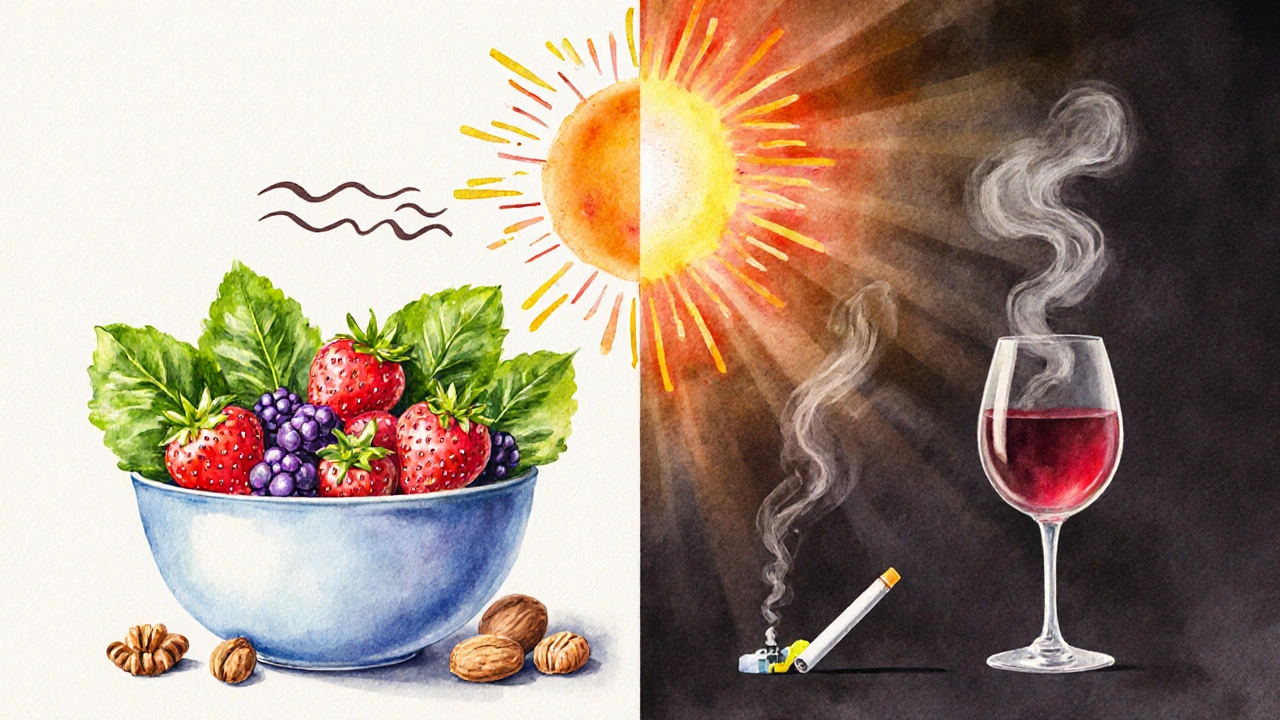
Smoking, Alcohol, and Their Hidden Effects
Smoking introduces free radicals and reduces blood flow, starving melanocytes of oxygen and nutrients. This oxidative stress can cause melanin to clump more tightly, deepening freckle colour.
Alcohol, especially in excess, dehydrates the skin and impairs the liver’s ability to clear toxins, which indirectly raises cortisol levels. Both habits act like a double‑hit: they increase oxidative stress and amplify the hormonal signals that promote melanin.
UV Radiation: The Amplifier
UV radiation from sunshine or artificial sources remains the primary driver of freckle formation. However, when combined with the stress‑related hormonal surge, the skin’s response becomes more pronounced. A 2024 clinical trial showed that participants under chronic stress needed 30% less UV exposure to develop visible freckles compared to a control group.
This synergy explains why many notice a spike in freckle intensity after a busy workweek followed by a weekend at the beach.
Practical Strategies to Manage Freckle Development
Below is a quick‑reference table that matches lifestyle tweaks with their impact on freckle appearance.
| Factor | Typical Effect | Actionable Tip |
|---|---|---|
| Chronic Stress | Increases cortisol → higher melanin production | Practice 10‑minute mindfulness or deep‑breathing daily |
| High‑Sugar Diet | Spikes insulin → stimulates melanocytes | Swap refined carbs for whole grains & low‑GI fruits |
| Smoking | Free radicals cause melanin clumping | Use nicotine replacement and aim for complete cessation |
| Excess Alcohol | Dehydrates skin & raises cortisol | Limit to 1-2 drinks/week; stay hydrated |
| Sun Exposure | Direct UV‑induced melanin synthesis | Apply broad‑spectrum SPF30+ 15min before sun, reapply every 2hrs |
Beyond these measures, keep your skin barrier healthy with gentle cleansers and moisturisers containing ceramides or hyaluronic acid. A strong barrier reduces the depth of pigment deposition.
When to See a Dermatologist
If you notice any of the following, it’s time to get professional advice:
- Freckles that change colour, size, or shape rapidly.
- New pigmented spots appearing outside typical sun‑exposed areas.
- Itching, bleeding, or a rough texture on a freckle.
A dermatologist can rule out conditions like lentigo or early melanoma and may suggest treatments such as topical hydroquinone, laser therapy, or chemical peels if aesthetic concerns are significant.
Putting It All Together
The takeaway is simple: stress, diet, smoking, alcohol and UV exposure all converge on the same melanin pathway. By moderating the factors you control - managing stress, eating antioxidant‑rich foods, quitting smoking, moderating alcohol, and protecting against UV - you can keep freckles from becoming more pronounced.
Remember, freckles are a normal variation of skin tone, but sudden changes are a signal to check in with a professional. With the right habits, you’ll notice a steadier, more even complexion that reflects how you feel inside.

Frequently Asked Questions
Can stress really make freckles darker?
Yes. Stress raises cortisol, which can boost the enzyme tyrosinase that makes melanin. Over time this can deepen existing freckles or create new ones, especially when combined with sun exposure.
Do antioxidants help fade freckles?
Antioxidants combat oxidative stress that encourages melanin clustering. Regular intake of vitamin C, vitamin E, and polyphenols can modestly lighten freckles over several months.
Is there a safe amount of sun exposure for people with freckles?
Any UV exposure can stimulate melanin, but using a broad‑spectrum SPF30+ sunscreen, seeking shade during peak hours, and wearing protective clothing can minimise new freckle formation while still allowing vitamin D synthesis.
Will quitting smoking improve my freckles?
When you stop smoking, oxidative stress drops, allowing the skin’s repair mechanisms to work more efficiently. Over a few months many people notice a subtle lightening of pigmented spots.
Should I consider professional treatments for freckles?
If freckles are a cosmetic concern and lifestyle changes haven’t helped, dermatologists can offer laser therapy, intense pulsed light (IPL) or topical agents. Always discuss risks and expected outcomes before proceeding.

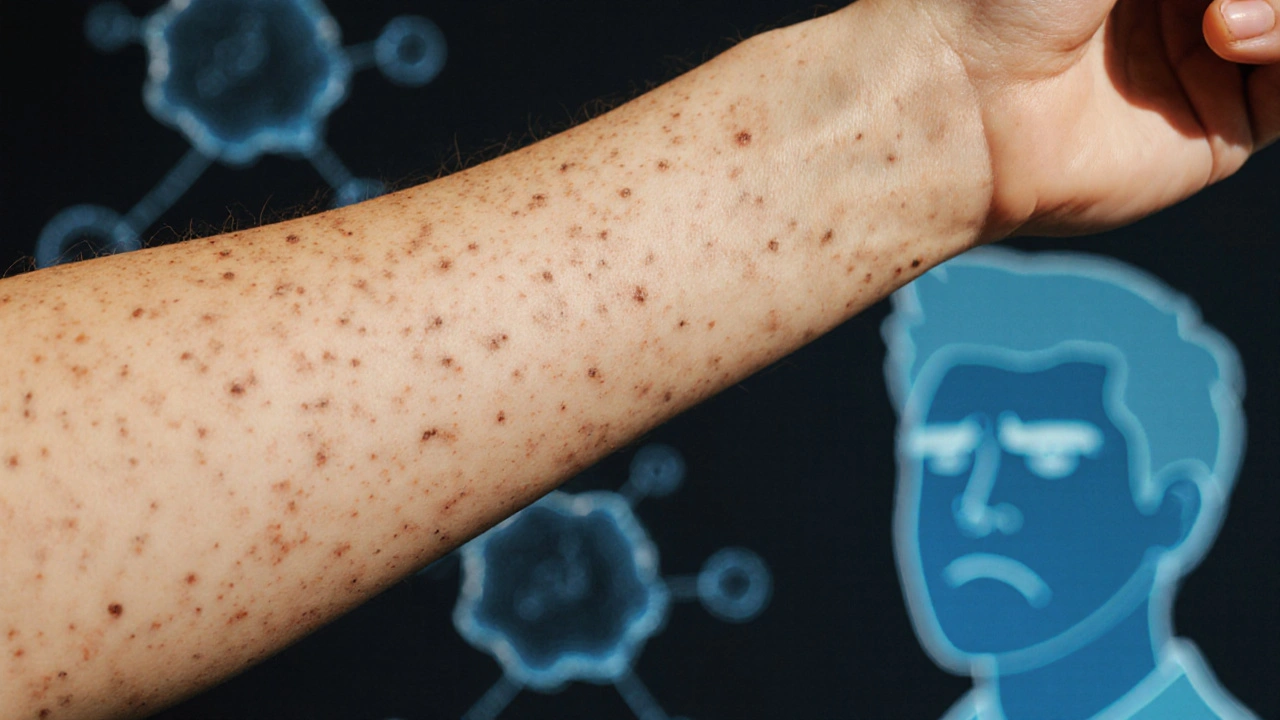
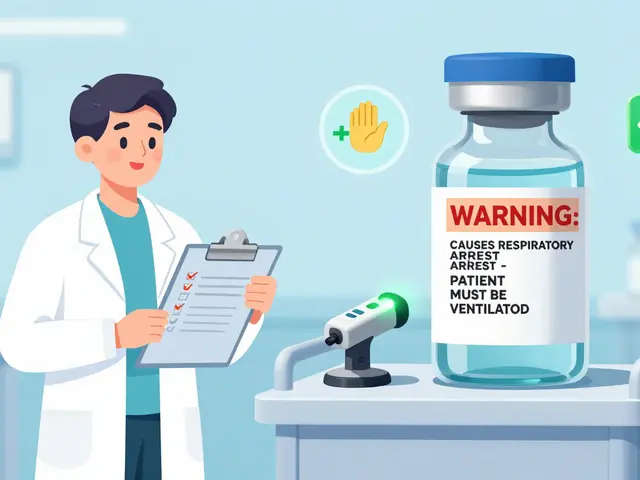
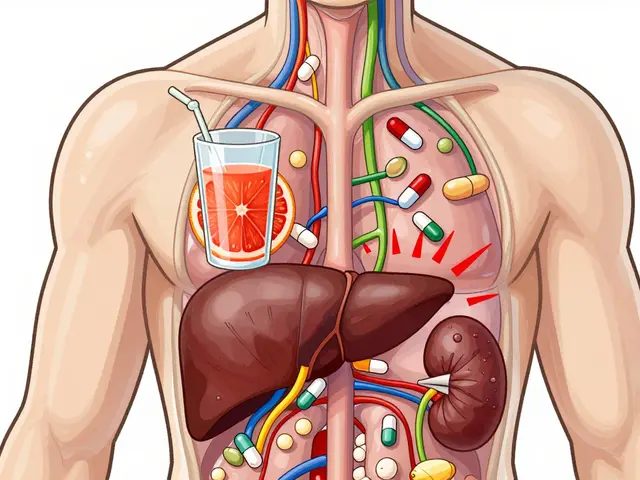
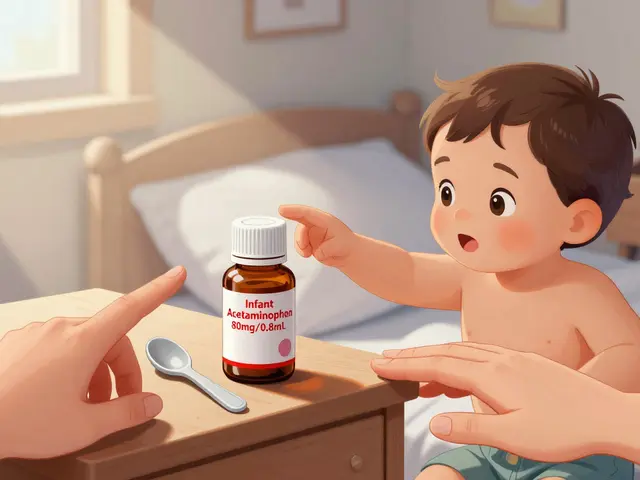
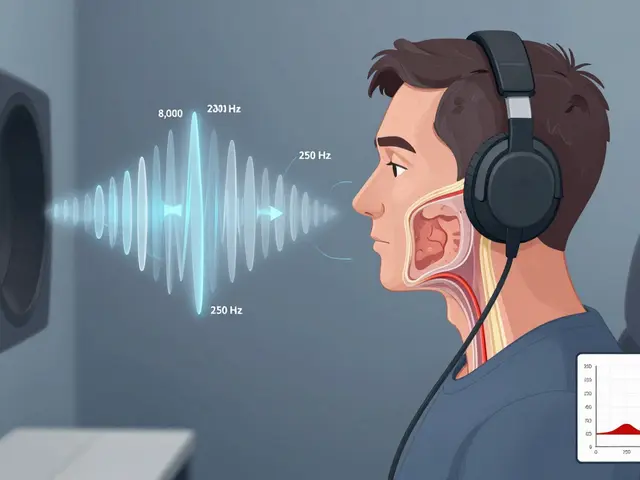
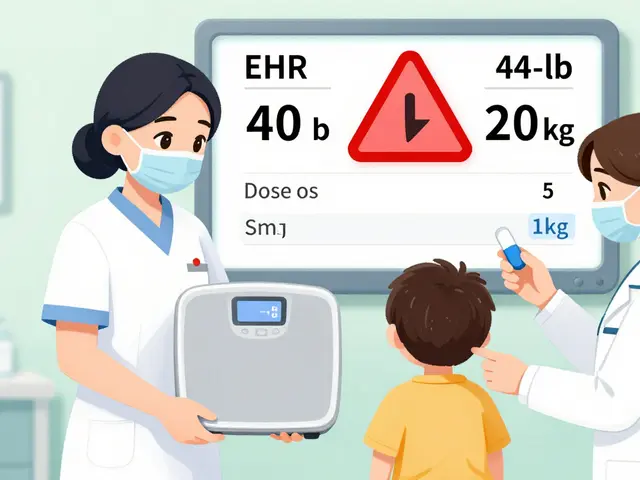
18 Comments
Jessica Tang
Stress triggers cortisol, which can up‑regulate tyrosinase activity in melanocytes. That means more melanin gets produced, especially in sun‑exposed spots. If you’re constantly juggling deadlines, those freckles can darken faster than you expect. Pairing stress‑management techniques like short meditation breaks with proper sunscreen can slow the process. Also, keeping a balanced diet rich in antioxidants helps counteract oxidative stress on the skin.
Consistent sleep improves hormone regulation, further reducing melanin spikes.
Alex Bennett
Ah, the classic "stress makes me look older" line, except here it’s freckles that get the memo. Funny how a little cortisol can turn a harmless sunspot into a tiny billboard for your anxiety. If you swap a coffee break for a breathing exercise, you might actually see those speckles mellow out. Keep the sunscreen handy, and maybe consider a hobby that doesn’t involve staring at a spreadsheet all day.
Mica Massenburg
They're hiding the real cause of freckles from us.
Sarah Brown
Let’s cut to the chase: lifestyle choices are the real puppeteers behind those little pigment parties. Smoking floods your skin with free radicals, making melanin clump tighter and darker. Excess booze? It dehydrates and spikes cortisol, giving your freckles a free ride. Swap those habits for antioxidant‑rich foods and watch the darkening slow down. Remember, the skin reflects what you feed it, both inside and out.
Max Canning
Yo, if you’re stressed, grab a quick 5‑minute walk and ditch that extra espresso. Sun’s a beast, so slather on SPF like it’s butter on toast. Swap sugary snacks for a handful of berries-your skin will thank you. Keep the vibes high and the patches low, you’ve got this!
Nick Rogers
Great point about the SPF, Max! Adding a daily antioxidant serum can boost the protection even further. Consistency is key; a short routine beats occasional over‑the‑top efforts.
Tesia Hardy
Totally agree w/ Sarah-quit smoking and your skin will look so much fresher. Also, try adding a vitamin C cream, it can help lighten those spots over time. Don’t forget to stay hydrated; water is the ultimate skin‑friend. Oh, and a quick typo: its" is "it's".
Keep up the good work!
Matt Quirie
Alex, your sarcasm is noted, but the science stands firm: cortisol does influence melanogenesis. Pairing stress reduction with diligent sun protection yields the best outcomes. It’s a straightforward protocol rather than a mystery.
Pat Davis
From a cultural perspective, freckles have historically been celebrated in many societies, yet modern lifestyle factors often undermine that natural beauty. The interplay between dietary antioxidants and UV exposure is especially crucial for those with fair skin. Moreover, the psychological impact of stress cannot be ignored, as it directly modulates melanin synthesis pathways. Implementing a balanced regimen-rich in fruits, vegetables, and regular sun safety-offers a comprehensive strategy. Finally, consulting a dermatologist when changes occur remains the prudent course of action.
Mary Wrobel
Freckles are like tiny constellations on our skin, each one telling a story of sunlight and lifestyle. When stress bubbles up, it can send those stars into overdrive, making them sparkle a bit too brightly. Eating a rainbow of fruits and veggies throws antioxidant fireworks at those melanin makers, calming the show. And let’s not forget the armor of SPF-your best defense against an uninvited UV party. A little mindfulness, a splash of lemon water, and a dash of laughter can keep the cosmic dust at bay. So, protect, nourish, and breathe-you’ll keep those freckles from turning into super‑novae. Keep shining, but in a balanced way!
Lauren Ulm
🤔 Ever notice how the powers that be don’t talk about the hidden stress‑melanin link? Some say it’s all natural, but the data hints at a coordinated effort to keep us guessing. 🌐 The antioxidants in berries? Probably a plant’s secret weapon, but why aren’t they advertised more? 🌱 Still, the best defense we have is staying informed, using SPF, and keeping the stress to a minimum. The truth may be out there, but we can still take practical steps today. 🚀
Michael Mendelson
Allow me to elucidate the profound intricacies underlying the phenomenon of freckle modulation. The interplay between cortisol-mediated tyrosinase activation and ultraviolet photonic influx constitutes a quintessential example of biochemical symbiosis. Moreover, the antioxidative capacity conferred by polyphenolic compounds operates not merely as a peripheral adjunct but as a pivotal regulatory axis. One must also consider the epigenetic ramifications of chronic alcohol consumption, which inexorably reshapes melanocytic gene expression. The cessation of tobacco, while ostensibly trivial, invokes a cascade of phytochemical restitution, thereby fortifying dermal resilience. Consequently, a multidisciplinary regimen-encompassing neuroendocrine equilibrium, photoprotection, and nutraceutical optimization-emerges as the apogee of dermatological praxis. In juxtaposition, the myopic reliance on cosmetic concealment reveals a lamentable neglect of foundational pathophysiology. It is incumbent upon the erudite practitioner to champion preventive stratagems over superficial remediation. To that end, the judicature of clinical acumen must be married to patient education, lest we perpetuate a cycle of transient aesthetic fixes. Ultimately, the quintessence of skin health resides in the harmonious convergence of lifestyle fidelity, hormonal homeostasis, and vigilant UV stewardship. This comprehensive schema, though perhaps esoteric to the layperson, epitomizes the zenith of evidence‑based skin stewardship. As such, the onus lies not merely with the individual but also with the broader medical community to disseminate this sagacious counsel with perspicacity and decorum.
Ibrahim Lawan
From a holistic standpoint, managing stress is as vital as applying sunscreen. Regular mindfulness practice can dampen cortisol spikes, thereby reducing melanin overproduction. Incorporating antioxidant‑rich foods-such as berries, leafy greens, and nuts-provides the skin with essential defenses against oxidative damage. Finally, a disciplined sun‑protection routine, re‑applying SPF every two hours, safeguards against UV‑induced pigment intensification.
Just Sarah
Indeed, Ibrahim presents a cogent synthesis; nevertheless, it is imperative to underscore the temporal dimension of intervention, i.e., initiating stress‑reduction protocols promptly can preempt the cascade of melanogenic activity. Moreover, the integration of dietary antioxidants should be calibrated to individual metabolic profiles, thereby maximizing efficacy. Lastly, consistent application of broad‑spectrum sunscreen, adhered to with scrupulous frequency, remains the cornerstone of photoprotection.
Anthony Cannon
Freckles, while often benign, serve as a visual marker of UV exposure and lifestyle factors. Simple steps-regular sunscreen, antioxidant intake, and stress management-can mitigate further darkening. When changes are abrupt, seeking dermatological advice is prudent.
Kristie Barnes
I’ve always loved my freckles, but lately they’ve seemed a bit more pronounced. I think the late‑night work sessions and a few extra glasses of wine might be part of it. I’m planning to add a daily vitamin C serum and keep the sunscreen on hand. Hopefully these small tweaks will keep my skin looking balanced without losing its character.
Zen Avendaño
Kristie’s approach is spot‑on; a gentle routine can make a big difference. Adding an antioxidant serum after cleansing can help brighten existing spots. Consistent SPF use, even on cloudy days, will protect against further pigment intensification. Remember, progress is gradual, so patience is key.
Michelle Guatato
The mainstream narrative downplays the covert agenda behind freckle proliferation. Industry giants profit from endless sunscreen sales while ignoring the stress‑induced melanin surge that they quietly amplify. Their silent endorsement of high‑glycaemic diets keeps the pigment cycle thriving. It’s no coincidence that “natural” antioxidants are rarely marketed aggressively. Stay vigilant, question the prescribed routines, and reclaim control over your skin’s destiny. The truth is out there; don’t let them dim your complexion.